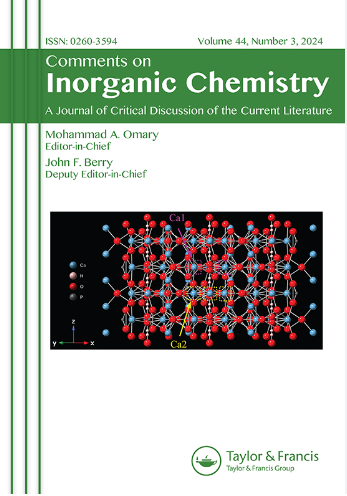Metal-Organic Frameworks-Based Electrocatalysis: Insight and Future Perspectives
IF 3.8
3区 化学
Q1 CHEMISTRY, INORGANIC & NUCLEAR
引用次数: 9
Abstract
Metal-organic frameworks (MOFs) are porous molecular compositions quickly emerging as a novel electro-optical platform, especially for various energy transduction processes. Such functionalities are intimately tied with the modular MOF chemistry required for the delineation of the wide range of tunable porous structures constructed from various electrooptically active linkers and or metal nodes. Various post-synthesis approaches further facilitate incorporation of key chemical functionalities that cannot be introduced into MOFs directly via de novo syntheses. While the tunable frameworks can provide a high areal concentration of electrooptically active species, the pore channels ensure substrate and ion flux, making these compositions highly accessible solid arrangements of molecular catalysts ideal for electro- and photoelectro chemical transformations. The recent surge of literature reports suggests unique features of energy and electron transfer processes within these framework compositions. Thus, understanding the unique features of electron transfer processes within the frameworks will help to delineate strategies for future functional materials. This review highlights some exemplary MOFs’ electrocatalysis to understand the interplay between catalytic and ET processes.基于金属-有机框架的电催化:洞察与未来展望
金属有机框架(mof)是一种多孔的分子组成,作为一种新型的光电平台迅速出现,特别是在各种能量转导过程中。这些功能与模块化MOF化学密切相关,这些化学是描述由各种电活性连接剂和/或金属节点构成的大范围可调多孔结构所必需的。各种合成后方法进一步促进了关键化学功能的结合,这些功能不能通过从头合成直接引入mof。虽然可调框架可以提供高面积浓度的光电活性物质,但孔通道确保了底物和离子通量,使这些组合物易于接近的分子催化剂的固体排列非常适合电化学和光电化学转化。最近大量的文献报道表明,在这些框架成分中,能量和电子传递过程具有独特的特征。因此,了解框架内电子转移过程的独特特征将有助于描述未来功能材料的策略。本文重点介绍了一些典型的mof电催化,以了解催化和ET过程之间的相互作用。
本文章由计算机程序翻译,如有差异,请以英文原文为准。
求助全文
约1分钟内获得全文
求助全文
来源期刊

Comments on Inorganic Chemistry
化学-无机化学与核化学
CiteScore
9.00
自引率
1.90%
发文量
18
审稿时长
>12 weeks
期刊介绍:
Comments on Inorganic Chemistry is intended as a vehicle for authoritatively written critical discussions of inorganic chemistry research. We publish focused articles of any length that critique or comment upon new concepts, or which introduce new interpretations or developments of long-standing concepts. “Comments” may contain critical discussions of previously published work, or original research that critiques existing concepts or introduces novel concepts.
Through the medium of “comments,” the Editors encourage authors in any area of inorganic chemistry - synthesis, structure, spectroscopy, kinetics and mechanisms, theory - to write about their interests in a manner that is both personal and pedagogical. Comments is an excellent platform for younger inorganic chemists whose research is not yet widely known to describe their work, and add to the spectrum of Comments’ author profiles, which includes many well-established inorganic chemists.
 求助内容:
求助内容: 应助结果提醒方式:
应助结果提醒方式:


